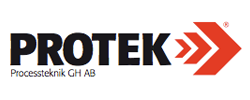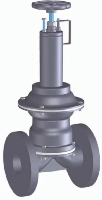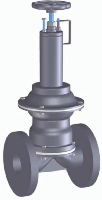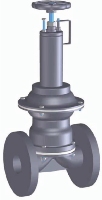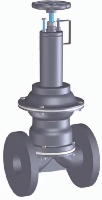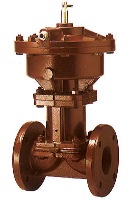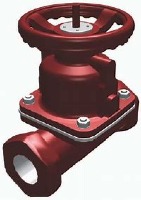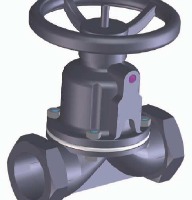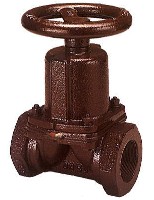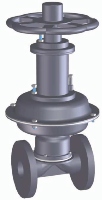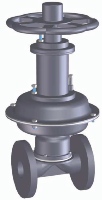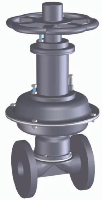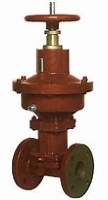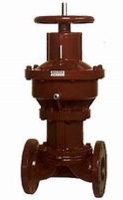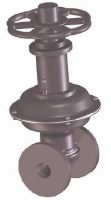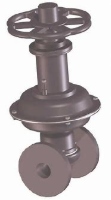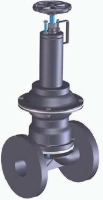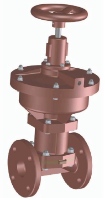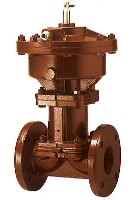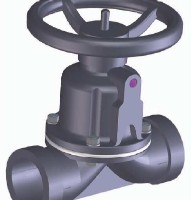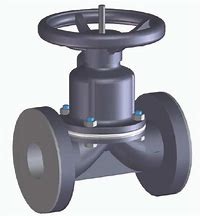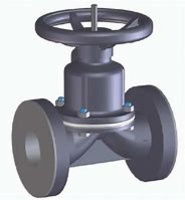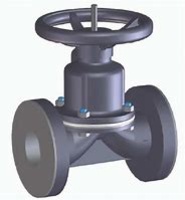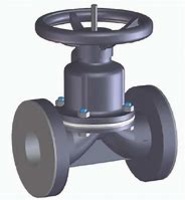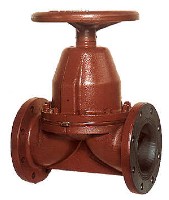G.S.54 diaphragm valve, of the guided flow type, are normally closed and are opened by a hydropneumatic cylinder with spring return.
The valve body and the diaphragm can be supplied, to customer’s specifications, in the materials most suitable for facilitating flow of the various liquids.
This model is fitted with a closing handwheel and with a ring nut for regulating opening.
G.S.54 diaphragm valve, of the guided flow type, are normally closed and are opened by a hydropneumatic cylinder with spring return.
The valve body and the diaphragm can be supplied, to customer’s specifications, in the materials most suitable for facilitating flow of the various liquids.
This model is fitted with a closing handwheel and with a ring nut for regulating opening.
G.S.54 diaphragm valve, of the guided flow type, are normally closed and are opened by a hydropneumatic cylinder with spring return.
The valve body and the diaphragm can be supplied, to customer’s specifications, in the materials most suitable for facilitating flow of the various liquids.
This model is fitted with a closing handwheel and with a ring nut for regulating opening.
G.S.54 diaphragm valve, of the guided flow type, are normally closed and are opened by a hydropneumatic cylinder with spring return.
The valve body and the diaphragm can be supplied, to customer’s specifications, in the materials most suitable for facilitating flow of the various liquids.
This model is fitted with a closing handwheel and with a ring nut for regulating opening.
G.S.54 diaphragm valve, of the guided flow type, are normally closed and are opened by a hydropneumatic cylinder with spring return.
The valve body and the diaphragm can be supplied, to customer’s specifications, in the materials most suitable for facilitating flow of the various liquids.
This model is fitted with a closing handwheel and with a ring nut for regulating opening.
G.S.53 diaphragm valve, of the guided flow type, are normally closed and are opened by a hydropneumatic cylinder with spring return.
The valve body and the diaphragm can be supplied, to customer’s specifications, in the materials most suitable for facilitating flow of the various liquids.
This model is fitted with a closing handwheel.
The G.S.51 diaphragm valve shown here is of the “conveyed flow” type with a loss of pressure below that of standard seat valves; according to the various operating conditions (which the user should kindly specify) the valve body can be cast iron, vulcanite and cast iron, glazed cast iron, light alloy, etc.; the diaphragm, in any case, consists of the material suitable for the specific service required from the valve. The head, complete with all control parts, consists of standard metals since the diaphragm protects it against any attack from fluids which the valve is supposed to control and check.?
?
The diaphragm is controlled in the opening and closing positions; as a result the valve can operate even under vacuum. It is recommended, on the other hand, never to exceed certain values of inner pressure also in connection with the valve size; users should specify on the enquiries, for this type of valves, the peak figures of pressure and temperature of the fluid with which the valves are in contact.?
?
The valves are available for flow diameters ranging from 15 to 350 mm; these valves are used extensively in chemical industries and chiefly in water’s treatment.
The G.S.51 diaphragm valve shown here is of the “conveyed flow” type with a loss of pressure below that of standard seat valves; according to the various operating conditions (which the user should kindly specify) the valve body can be cast iron, vulcanite and cast iron, glazed cast iron, light alloy, etc.; the diaphragm, in any case, consists of the material suitable for the specific service required from the valve. The head, complete with all control parts, consists of standard metals since the diaphragm protects it against any attack from fluids which the valve is supposed to control and check.?
?
The diaphragm is controlled in the opening and closing positions; as a result the valve can operate even under vacuum. It is recommended, on the other hand, never to exceed certain values of inner pressure also in connection with the valve size; users should specify on the enquiries, for this type of valves, the peak figures of pressure and temperature of the fluid with which the valves are in contact.?
?
The valves are available for flow diameters ranging from 15 to 350 mm; these valves are used extensively in chemical industries and chiefly in water’s treatment.
The G.S.51 diaphragm valve shown here is of the “conveyed flow” type with a loss of pressure below that of standard seat valves; according to the various operating conditions (which the user should kindly specify) the valve body can be cast iron, vulcanite and cast iron, glazed cast iron, light alloy, etc.; the diaphragm, in any case, consists of the material suitable for the specific service required from the valve. The head, complete with all control parts, consists of standard metals since the diaphragm protects it against any attack from fluids which the valve is supposed to control and check.?
?
The diaphragm is controlled in the opening and closing positions; as a result the valve can operate even under vacuum. It is recommended, on the other hand, never to exceed certain values of inner pressure also in connection with the valve size; users should specify on the enquiries, for this type of valves, the peak figures of pressure and temperature of the fluid with which the valves are in contact.?
?
The valves are available for flow diameters ranging from 15 to 350 mm; these valves are used extensively in chemical industries and chiefly in water’s treatment.
The G.S.51 diaphragm valve shown here is of the “conveyed flow” type with a loss of pressure below that of standard seat valves; according to the various operating conditions (which the user should kindly specify) the valve body can be cast iron, vulcanite and cast iron, glazed cast iron, light alloy, etc.; the diaphragm, in any case, consists of the material suitable for the specific service required from the valve. The head, complete with all control parts, consists of standard metals since the diaphragm protects it against any attack from fluids which the valve is supposed to control and check.?
?
The diaphragm is controlled in the opening and closing positions; as a result the valve can operate even under vacuum. It is recommended, on the other hand, never to exceed certain values of inner pressure also in connection with the valve size; users should specify on the enquiries, for this type of valves, the peak figures of pressure and temperature of the fluid with which the valves are in contact.?
?
The valves are available for flow diameters ranging from 15 to 350 mm; these valves are used extensively in chemical industries and chiefly in water’s treatment.
The G.S.51 diaphragm valve shown here is of the “conveyed flow” type with a loss of pressure below that of standard seat valves; according to the various operating conditions (which the user should kindly specify) the valve body can be cast iron, vulcanite and cast iron, glazed cast iron, light alloy, etc.; the diaphragm, in any case, consists of the material suitable for the specific service required from the valve. The head, complete with all control parts, consists of standard metals since the diaphragm protects it against any attack from fluids which the valve is supposed to control and check.?
?
The diaphragm is controlled in the opening and closing positions; as a result the valve can operate even under vacuum. It is recommended, on the other hand, never to exceed certain values of inner pressure also in connection with the valve size; users should specify on the enquiries, for this type of valves, the peak figures of pressure and temperature of the fluid with which the valves are in contact.?
?
The valves are available for flow diameters ranging from 15 to 350 mm; these valves are used extensively in chemical industries and chiefly in water’s treatment.
The G.S.51 diaphragm valve shown here is of the “conveyed flow” type with a loss of pressure below that of standard seat valves; according to the various operating conditions (which the user should kindly specify) the valve body can be cast iron, vulcanite and cast iron, glazed cast iron, light alloy, etc.; the diaphragm, in any case, consists of the material suitable for the specific service required from the valve. The head, complete with all control parts, consists of standard metals since the diaphragm protects it against any attack from fluids which the valve is supposed to control and check.?
?
The diaphragm is controlled in the opening and closing positions; as a result the valve can operate even under vacuum. It is recommended, on the other hand, never to exceed certain values of inner pressure also in connection with the valve size; users should specify on the enquiries, for this type of valves, the peak figures of pressure and temperature of the fluid with which the valves are in contact.?
?
The valves are available for flow diameters ranging from 15 to 350 mm; these valves are used extensively in chemical industries and chiefly in water’s treatment.
The G.S.51 diaphragm valve shown here is of the “conveyed flow” type with a loss of pressure below that of standard seat valves; according to the various operating conditions (which the user should kindly specify) the valve body can be cast iron, vulcanite and cast iron, glazed cast iron, light alloy, etc.; the diaphragm, in any case, consists of the material suitable for the specific service required from the valve. The head, complete with all control parts, consists of standard metals since the diaphragm protects it against any attack from fluids which the valve is supposed to control and check.?
?
The diaphragm is controlled in the opening and closing positions; as a result the valve can operate even under vacuum. It is recommended, on the other hand, never to exceed certain values of inner pressure also in connection with the valve size; users should specify on the enquiries, for this type of valves, the peak figures of pressure and temperature of the fluid with which the valves are in contact.?
?
The valves are available for flow diameters ranging from 15 to 350 mm; these valves are used extensively in chemical industries and chiefly in water’s treatment.
